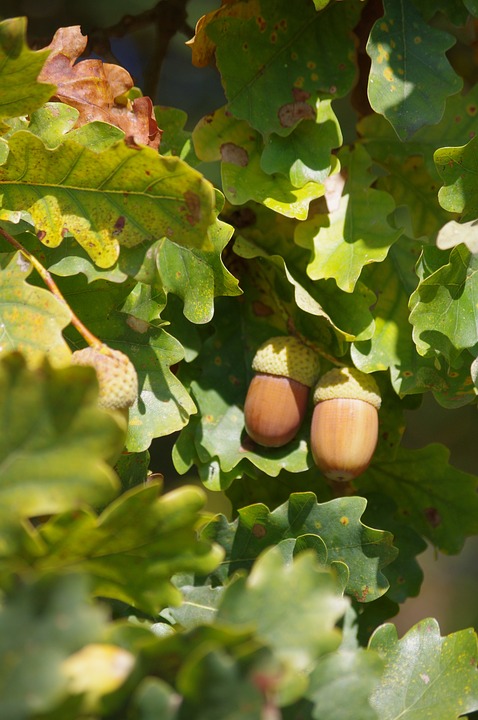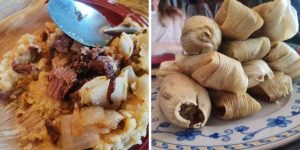Acorns used to be a major food source for Native American—and with good reason. They were everywhere, were easy to gather, and stored fairly well . . . as long as they were kept in a squirrel-proof container!

How to Cook with Acorns
Acorns are gathered in the fall after they are ripe. Early in the season, you will occasionally find acorns without their “little hats” lying on the ground. These are usually buggy. (If the acorn is so heavy that it pulls itself from its cap, it is usually because there is a worm flipping itself about inside the acorn. All this activity is what breaks the nut free from its cap and the tree.)
When the acorns are actually ripe, they fall from the tree, cap intact. If you see any holes in them, throw them away. They are sometimes stored first, to dry them out, and then shelled. Other groups shell them first, and then dry them out by placing them someplace safe yet warm to dry.
3 Ways to Process Acorns
For the ultimate in information on processing acorns, check out the book It Will Live Forever: Traditional Yosemite Indian Acorn Preparation by Julia Parker and Beverly Ortiz.
Traditional Leaching Method
There is, first and foremost, the original recipe: after the acorns are completely dry and removed from their shells, they’re ground until the meal is so fine that “it will stick to the basket sifter” when it is turned upside down. When you have determined that you have ground the acorns enough, you must then leach it.
More from the Homestead Guru: This is What It’s REALLY Like to Live in the Wilderness
This was traditionally accomplished (before we had woven cloth to work with) by building a mound of fine sand, near a spring or the river, and then scooping out the center. The meal you wished to leach was placed in the center of this mound and water poured over a clean cedar bough, which was placed or held above the acorn meal. The tannins would leach out of the acorn meal into the sand. When tasting it showed the tannins had been removed, the meal was carefully removed from its sand “colander” and put into a cooking basket.
Water was added—the correct amount for the amount of acorn meal they were going to use, which is a skill often learned through experience. Too much water would require cooking longer to get the desired consistency. Not enough water, and the acorn meal would burn.
Then, special cooking rocks were heated in a fire, rinsed off, and—using special stirring sticks—the rocks were stirred in the basket to heat the acorn solution thoroughly. As each rock cooled down, it was removed, and another hot, clean rock took its place in the cooking basket. The rock that had been removed was washed off and placed back in the fire to reheat and await its turn to become a cooking implement once again. In a short time, the acorn soup came to boiling, and the stirring continued until the soup was of the desired consistency—either thin, to eat with a spoon, or thicker, to eat with a fork—depending on what the cook had in mind.
Though the above soup was eaten straight by the traditional people, I usually add a little salt, and occasionally some dried currents or blue elderberries, or even raisins. Some people like to add a little cinnamon.
Alternative Leachings Method and Natural Dying Uses
The Basket Method
An alternative method of leaching is to take a broad-bottomed basket; place a clean, white, unbleached cloth (like a tea towel used just for this purpose . . . which will never be white again) in the bottom of the basket; and then place your finely ground acorn meal on top of the cloth. Get a piece of cedar branch—new growth preferred—and place it on top of the acorn meal. Run water on it very slowly.
More from The Homestead Guru: Honey is Medicine! Don’t just eat it!
Place your basket on top of a large cooking pot (so that you can save the tannin water) in such a way that when the pot fills up, the basket won’t be sitting in the water, and the pot can overflow. Check on the leaching process periodically, so you can empty the soup kettle as it fills.
If you do natural dying, you can pour the tannin-filled water into the washing machine and add in up to 4 pounds of clean, white wool or yarn so it can soak up the tannic acid solution. This way, when you’re ready to dye the wool, the color will come out much brighter than it would if it had been applied to untreated fleece.
The Toilet Tank Method
Another way I have heard of to leach acorn, which I have never tried and probably never will, is to scrub the water tank on your toilet to remove any algae, and use this “sanitary” part of your toilet to leach your acorn meal.
It makes sense to use water that otherwise is wasted, but it doesn’t seem like a very polite topic of conversation for a public gathering . . . . I can hear it now:
“Gee, this acorn mush isn’t half bad. . . . You must have leached it really thoroughly.”
“Why, yes, I did. I let it sit in a clean muslin bag in my toilet tank for a week or so.”
Then watch your dinner guests put their food down, never to eat at your campfire again.
FYI, the girl who shared this bit of information with us had just remodeled her house, had a brand new toilet (and hence no green film in the tank), and thought it was the perfect opportunity to try out a method she had heard of, or had a theory about. She also went on to say that she was glad her new toilet was a pale brown color because the tannins discolored her toilet bowl for quite some time.
More from the Homestead Guru: How to Enjoy Fresh Flavors Year Round + 5 Easy Indoor Herbs
4 Acorn Recipes
Below is a recipe that’s good to serve those who stubbornly believe that acorn meal is yucky. They’ll never even know it’s there unless you tell them later. If you want to be sure you are actually tasting the meal, use the recipe exactly as-is. Once you feel confident that you wish to include the meal, but you want to add more character to the stew, feel free to add garlic, green pepper, carrots, etc.
Traditional Venison Acorn Stew
2 pounds venison, cut up
1 cup finely ground acorn meal
Cover venison with water in pot or basket. Add hot rocks to simmer until meat almost falls apart. Remove meat from broth and chop into fine pieces. Return to pot with liquid and stir in acorn meal. Serve hot.
Acorn Stew
1 pound stewing beef
1/2 cup finely ground acorn meal (tannins removed)
Salt and pepper to taste
Place beef in heavy pan and add water to cover. Cover with lid and simmer until very tender. Remove from liquid and cut meat into very fine pieces. Return meat to the liquid. Stir in the acorn meal. Add salt and pepper as desired. Heat until thickened and serve.
Ethnic food enthusiasts like to substitute acorn meal for corn meal when making muffins—usually using 1/2 corn meal and 1/2 acorn. Some have substituted 1/2 of the flour in a biscuit recipe with 1/2 acorn meal. Experiment carefully, remembering that a good portion of the work performed by flour has to do with the gluten in it. Acorn meal has no gluten, so you’ll have to keep this in mind.
Here is a modern Acorn Bread recipe from the book Cooking with Spirit: North American Indian Food and Fact.
Acorn Bread
6 Tablespoons cornmeal
1/2 cup cold water
1 cup boiling water
1 teaspoon salt
1 Tablespoon butter
1 package active dry yeast
1/4 cup lukewarm water
1 cup mashed potatoes
2 cup all-purpose flour
2 cup finely ground, leached acorn meal
Mix cornmeal with cold water. Add boiling water and cook 2 minutes, stirring constantly. Add salt and butter, and cool to lukewarm. Soften yeast in lukewarm water. Add remaining ingredients to corn mixture, along with yeast. Knead to a stiff dough. Dough will be sticky. Cover and let rise in a warm place until doubled in bulk. Punch down; shape into two loaves; cover and let rise until doubled in bulk. Bake at 375°F for 45 minutes.
Acorn Griddle Cakes
2/3 cup finely ground, leached acorn meal
1/3 cup unbleached flour
1 teaspoon baking powder
1/3 teaspoon salt
1 Tablespoon honey
1 egg, beaten
3/4 cup milk
3 Tablespoon melted butter
Combine dry ingredients. Mix together egg and milk, then beat into dry ingredients, forming a smooth batter. Add butter. Drop batter onto hot, greased griddle. Bake, turning each cake when it is browned on underside and puffed and slightly set on top. Makes 12 to 15.
We Want to Hear From You!
What’s your favorite way to leach and/or cook with acorns? Share your thoughts in the comments below!
This article was originally published on The Grow Network.




